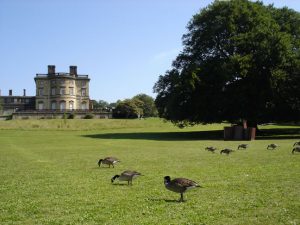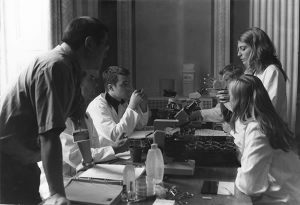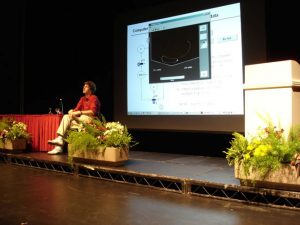

Ten years after the first Gatsby Plant Science Summer School, I’d like to introduce the first of a series of blogs to highlight some of the progress made in the science presented 10 years ago and include stories from some of the alumni of their journeys since 2005.
I’m keen to hear from any past participant so please pass on this link.
In July 2005, the first Gatsby Plant Science Summer School took place at Bretton Hall, Yorkshire, when the University of Leeds owned the mansion buildings within the grounds of The Yorkshire Sculpture Park and the University’s Department of Performance and Cultural Industries was based there. (Bretton Hall was sold in 2007 and it seems its future will be a hotel complex). Ninety-four end of first year undergraduates attended from the then 17 Universities in the Gatsby plant science network. The opening plenary was given by Professor Sir Peter Crane, the then Director of Kew Gardens and other research talks were given by:- Ottoline Leyser, Angela Karp, Enrico Coen, Julian Ma, Jeff Dangl, Chris Pollock, Andrew Millar, Howard Atkinson. Arts students delivered an entertaining social programme. Fifty-nine participants (speakers, plenary and practical tutors) from over 20 institutions enthusiastically delivered their respective contributions. It was a success!
Ten years on, I asked Professor Andrew Millar FRS (University of Edinburgh) to comment on changes in his research area of Circadian Rhythms since his talk in 2005. I just caught him before he disappeared to Seattle on sabbatical. Andrew replied, “In 2005, I described our very first mathematical model of the 24-hour, biological clock that gives plants daily rhythms. We had an essential but unknown component standing in for everything we didn’t know, along with the two genes that we did know. The current model is complicated, because many more clock genes have been located in the circuit, and the unknowns have shrunk correspondingly. More important, we understand far better how the clock genes control growth and we know they are important in crop species as well as Arabidopsis. Our clock models now connect to the whole plant, through flowering physiology, hypocotyl elongation, starch metabolism, and genome-wide transcription. Next, we need to know how the clock works with other regulators, under natural conditions.” Andrew returned to talk at the 2012 summer school and you can see the talk he gave then at The Plant Science TREE.

We know that the 2005 school inspired several students to pursue plant science study (see Levesley et al., 2012). The next blog will focus on one of their stories but I’d like to use this opportunity to appeal to all summer school alumni to get in touch with me and update their contact details.
Are you a summer school alumnus or do you know someone who is? I’d love to hear from you and especially if your area of work or study relates to plant science.
You can email me at celia.knight@slcu.cam.ac.uk
Until the next blog, all the best.
A Brief History of the Gatsby Plant Science Summer School
When I made the proposal to the Gatsby Charitable Foundation in 2004, I had a clear view of how the programme could work and that a special experience was needed to help first year undergraduates think more positively about plant science and its career opportunities. With the generosity of Gatsby and some great input from very many colleagues, especially from the Centre for Plant Sciences and the School of Biology at the University of Leeds, I just had to make it happen. I was joined in 2005 by Aurora Levesley and by Juliet Jopson in 2006 and in 2012 we published an analysis of the school’s impact in its first 4 years, showing that students who attended the summer school were almost 4 times more likely to enter plant science-related PhDs than their peers who did not.
Summer school lectures and other on-line resources that can be used to inspire many more than the now 80 fortunate high-achievers selected to attend the school each year can be found on The Plant Science TREE which Aurora continues to coordinate with Professor Alison Baker at The University of Leeds. In 2014 we published an analysis of the TREE’s impact showing the power of quality on-line lectures in reaching a global audience.
The format of the one week residential school, which takes place at the end of June/beginning of July, is relatively unchanged since 2005. Minor modifications are made after each year’s reviews with input from the Gatsby Plant Science Advisors and others. Since 2008, the school has taken place at The Hawkhills (also known as the Emergency Planning College) in Easingwold, north of York – an excellent venue for this event.
The programme however is something I take considerable time over each year to get a relevant and engaging list of talks, practicals and career events. I aim to get a good mix of academic and professional participants so that a broad spectrum of people have input to the school – this can also lead to some excellent networking opportunities.
Increasingly, I can recommend to students a number of “summer studentship or internship opportunities” to undertake the year following the summer school to give them a taster of plant science research or relevant work. Independently, I am recommending some Targeted Internships for Defra that address their R&D needs. The summer school appeals to institutions offering placements so I hope this area will grow.
Since 2010, the opportunity to take part in the summer school has been extended to a few school teachers each year and from 2014, the summer school has been integrated into the Gatsby Plant Science Education Programme based at The University of Cambridge with Claire Pennycuick key to its operational success. The alignment now of the undergraduate summer school with the Science and Plants for Schools programme run by Ginny Page with colleagues Dan Jenkins and Harriet Truscott, provides an excellent opportunity to focus on plant science education for the 11-21 age range.
As well as continuing to open the eyes of first year undergraduates to plant science, so that they return to their respective Universities motivated to take up plant-related courses, internships, further study etc. I think we now also have a real opportunity for the impact of the undergraduate summer school to assist the excellent work of the SAPS team in inspiring school students and teachers about plant science.
I look forward to another great summer school starting 28th June and to many more developments from the week.

